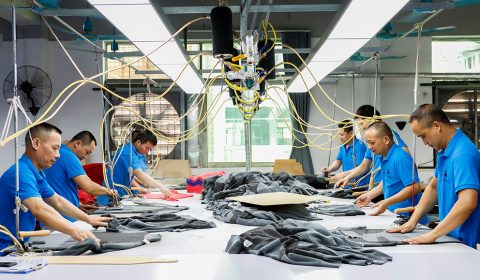Quality cashmere for softness and silky touch
Premium cashmere is known for its excellent softness and silky touch. Behind this touch is a high quality cashmere fibre, usually from a high quality mountain sheep or Tibetan antelope. These animals live in harsh natural environments, so their downy hairs develop thinner, longer fibers with excellent touch. This softness is not only the surface feeling, but also due to the internal microstructure of the cashmere fiber, which makes the wearer feel warm and comfortable.
The softness of high-quality cashmere is also related to the fineness of the fibers. Fine fibers are generally softer, so manufacturers tend to prefer thinner fibers when choosing raw materials. This soft feel not only provides extreme comfort, but also makes cashmere the ideal material for high-end clothing.
Compared with high-quality cashmere, inferior cashmere often shows a rougher and uncomfortable feel. This can be due to low-quality raw materials, such as substandard wool mixed with more coarse fibers, or neglect of fineness and softness in the production process. Rough feel is usually manifested as the surface of the sweater is not smooth and inconsistent, giving the wearer an unpleasant touch.
The uncomfortable feel of inferior cashmere may also be affected by the processing technology. Improper handling and washing processes may lead to increased burr on the surface of the cashmere fiber, which in turn reduces the overall tactile quality. Therefore, when buying cashmere products, it is very important to pay attention to the details of the feel, which helps to judge its quality and comfort.
Through a detailed examination of the feel and hand feel, we can better understand the quality differences of cashmere and ensure that the selected cashmere products provide excellent comfort and tactile experience.
The long, fine fiber of fine cashmere
The fiber length and fineness of high quality cashmere are directly related to the quality of cashmere products. This type of cashmere usually comes from high-quality wool, in which the fiber length is longer and the fineness is finer. This long, fine fiber property gives cashmere its outstanding softness and silky touch.
The fiber length of cashmere is determined by the breed of sheep and the breeding environment. For example, wool from the highlands is usually longer because wool in these areas grows more slowly and the fibers have more time to develop. The long fibers of high-quality cashmere help increase the strength of the fabric, reduce the likelihood of pilling, and maintain the shape of the sweater.
Long fibers also help the fabric retain color better because the fiber has a larger surface area and absorbs and reflects light more easily. This makes the color more vivid and long-lasting, making cashmere products more attractive.
Compared to high-quality cashmere, inferior cashmere usually contains short and coarse fibers, which has a direct and negative impact on the quality of cashmere products. Short fibers are easy to break, resulting in wear and damage to the fabric. In addition, the short fibers form a more pronounced pilling on the surface of the fabric, giving the sweater an untidy look.
The thickness of the fiber is directly related to the softness of the cashmere. The coarse fibers in poor quality cashmere may make the fabric feel rough and lose the softness and comfort that cashmere products should have. This also affects the thermal performance of cashmere, as the fine fibers are better able to form an air layer in the fabric, providing better insulation.
When buying cashmere products, it is very important to pay attention to the length and fineness of the fiber, because they are one of the key indicators to judge the quality of cashmere. Choosing cashmere with long and fine fibers not only allows for better touch and comfort, but also ensures the durability and appearance of the product.
Fiber color and gloss
The color of high-quality cashmere is one of the distinguishing signs of its quality and appearance. In high-quality cashmere, the fibers usually show an even, consistent color. This uniformity indicates that the animal’s hair has been well cared for and properly fed during growth, so the cashmere produced is more even. This feature is directly related to the appearance of cashmere products, making them look more upscale and aristocratic.
In addition, high-quality cashmere also shows a natural shine. Gloss refers to the ability of cashmere fibers to reflect and scatter light in light. The shine of quality cashmere is usually natural and does not require additional gloss agents or chemical treatments. This natural gloss gives cashmere products a unique brightness, making them show a charming luster in the sun or light.
Compared with high-quality cashmere, inferior cashmere often has obvious color difference and uneven luster. This may be due to the animal’s unbalanced diet, poor living environment, or hair mixed with impurities. Uneven color may cause cashmere products to be difficult to achieve a consistent tone when dyeing, affecting the overall appearance. Uneven luster shows that the product shows different gloss in different parts, making the whole appear uncoordinated and dull.
In addition, some poor quality cashmere may be chemically treated to increase gloss. However, this treatment usually causes the cashmere to lose its natural appearance and instead appears too smooth and lacks natural texture.
Origin and brand reputation
The origin of cashmere is one of the important factors affecting the quality of cashmere. The climate, feeding methods and breeding conditions in different regions will directly affect the fiber quality of cashmere. For example, in places such as the Mongolian Plateau and New Zealand, cashmere is usually softer, finer and more resilient due to the cold climate and good breeding conditions. In contrast, some cashmere produced in warm climates or areas with poor feeding conditions may be of poor quality.
In addition, the reputation of the brand is also a key factor in evaluating the quality of cashmere. Well-known brands often conduct strict checks on the source of raw materials and adopt high standards of craftsmanship in the manufacturing process. By purchasing cashmere products from reputable brands, consumers are more likely to obtain high quality cashmere, as these brands tend to have a wealth of experience and commitment to product quality.
Before purchasing a cashmere product, knowing the credibility of the brand is a key step in ensuring quality cashmere. First, you can look at consumer reviews and professional reviews to understand other consumers’ purchasing experience and comments on the brand. Well-known brands usually establish a good reputation in the market because they generally pay attention to product quality, customer service and social responsibility.
Secondly, it is best to consult the brand’s official website before shopping to understand the brand’s history, values and manufacturing process. Some brands may provide detailed information about cashmere origin, sourcing standards and production processes, which helps build trust in the brand. In addition, by looking at the brand’s certifications and awards, it is also possible to better understand the brand’s position and reputation in the industry.
Price and Ingredient label
Price is one of the important factors to pay attention to when buying cashmere products. Too low a price can be a telltale sign of poor quality cashmere. High-quality cashmere products usually need to pay a higher cost, because the production process needs to use high-quality wool, procurement and processing costs are relatively high. Therefore, consumers should be vigilant when seeing cashmere at significantly lower prices than the market price.
Low price cashmere products may be due to the following reasons: First, it may use inferior wool, its fiber is short and thick, resulting in poor texture of the finished product. Secondly, the production process may lack strict quality control, resulting in a lower overall quality of the product. Finally, the low price may be due to the addition of a large amount of blended materials, which reduces the cost but also reduces the quality of the product.
For consumers, understanding the market, comparing the prices of different brands, and paying attention to discount seasons and shopping festivals are all ways to help them identify the quality of cashmere. In general, the low price should cause consumers to worry about the quality of cashmere, because high-quality cashmere has a certain production cost.
Ingredient label is one of the key information to judge the quality of cashmere. When buying cashmere, it is important that shoppers carefully check the product label to ensure that the product is pure cashmere and not a blend. Blended cashmere often contains other fibers, such as polyester or silk, which reduces the purity and quality of the product.
First, check the label to see if it says “100% cashmere” or “pure cashmere” to ensure a single ingredient in the product. If the label is vague or contains other fiber ingredients, it may be a blended product. Second, pay attention to the origin and brand information of cashmere on the label. Some well-known brands provide more detailed information on product labels, which helps to ensure the quality of the product.
For dark or patterned cashmere products, you should also check the dye information on the label to ensure that the dyeing process does not affect the texture of the cashmere. Shoppers can choose products with clear labels, detailed information and reputable brands to reduce the risk of buying blended cashmere.




 English
English Deutsch
Deutsch Français
Français Italiano
Italiano Español
Español Русский
Русский Polski
Polski Nederlands
Nederlands Svenska
Svenska

